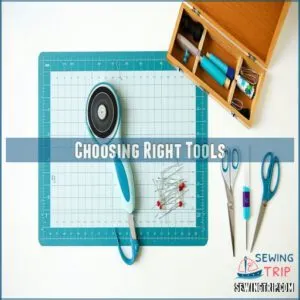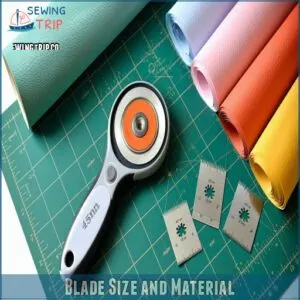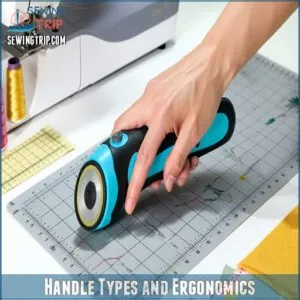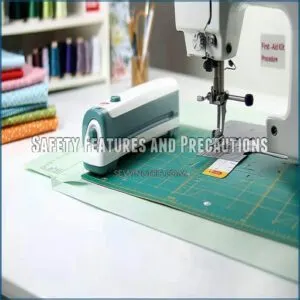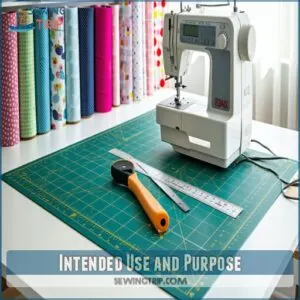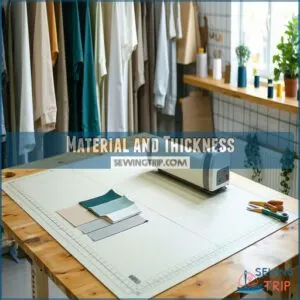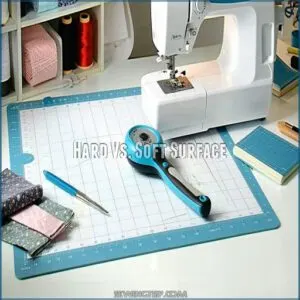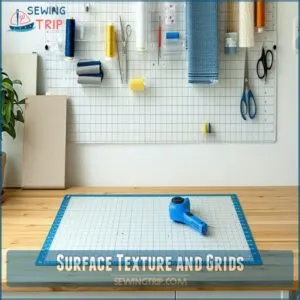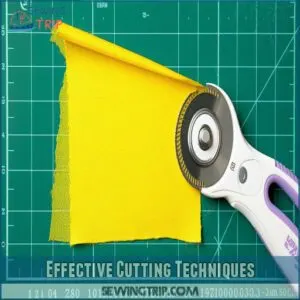This site is supported by our readers. We may earn a commission, at no cost to you, if you purchase through links.
 For the best rotary cutter and mat for sewing projects, you’ll want tools that balance precision, durability, and safety.
For the best rotary cutter and mat for sewing projects, you’ll want tools that balance precision, durability, and safety.
A self-healing mat, like the Dahle Vantage 10693, resists cuts and scratches, ensuring a smooth surface for clean lines, while its non-slip bottom keeps it in place.
Pair it with a 45mm rotary cutter featuring a tungsten steel blade for long-lasting sharpness—consider options like the Fiskars Rotary Cutter Fabric Cutting Set for ergonomic comfort and safety locks.
These tools make cutting layers of fabric effortless, ready to cut with confidence, the right setup definitely transforms your sewing game.
Table Of Contents
Key Takeaways
- Choose a self-healing cutting mat for durability and a smooth cutting surface that resists nicks and extends mat life.
- Go for a 45mm rotary cutter with a tungsten steel blade to ensure sharp, precise cuts through multiple fabric layers.
- Opt for mats with clear grid lines and a non-slip bottom to improve cutting accuracy and prevent slipping during use.
- Look for ergonomic rotary cutter handles with safety locks to enhance comfort and prevent accidents during long cutting sessions.
Choosing Right Tools
Choosing the right rotary cutting tools can elevate your sewing projects. We’ll guide you through selecting the perfect rotary cutter and mat, ensuring precise, efficient, and enjoyable crafting experiences.
Material Composition
The material of your rotary cutter mat sets the tone for your crafting journey. It’s like choosing the right canvas for your masterpiece. You want a mat that can take a beating but still keeps your table safe.
When selecting a mat, consider investing in a high-quality self healing mat for maximum durability and performance, as seen in self healing mat.
- Fabric Density: Go for mats with a three-layer construction, like self-healing mats, to resist cuts and scratches.
- Material Durability: Rotary cutter mats are typically made from heavy-duty plastic, cardboard, or PVC. PVC mats are self-healing, keeping their smooth surface longer.
- Cutting Resistance: Premium steel or titanium blades call for a mat that can handle them, like a self-healing mat.
Size Considerations
Choosing the right mat size depends on your project and space.
Go big for ample room to maneuver large fabric pieces, but if you’re tight on space or handling smaller crafts, a compact mat like the Fiskars 14" x 14" model is ideal.
The sweet spot is a mat that accommodates your fabric measurements with a bit of wiggle room for cutting efficiency.
So, match your rotary cutter mat to your project’s scale and space.
When selecting a mat, consider the rotary cutter mat features that suit your sewing needs for peak performance.
Non-Slip Bottom Surfaces
A cutting mat’s size is key, but don’t forget what keeps it in place: that nonslip surface.
A stable cutting mat is your best friend.
Look for these features in your next cutting mat:
- Surface Grip
- Mat Stability
- Bottom Texture
- Slip Resistance
- Adhesive Backing
These features guarantee your rotary cutting mat stays put, no matter how enthusiastic your cutting session gets.
A solid nonslip surface lets you focus on precision with your rotary cutter and self-healing mat, not chasing a runaway cutting mat.
Self-Healing Technology
Self-healing mats are a cut above the rest.
The unique three-layer construction means your mat can withstand hundreds of cuts without damage.
Self-healing mats keep their smooth surface, so your rotary cutter glides through fabric with precision.
This tech also extends the lifespan of your mat, saving you money and ensuring cutting efficiency.
A self-healing mat is a must-have for any rotary cutter enthusiast.
The quality of a self healing mat substantially affects the overall sewing experience.
Rotary Cutter Basics
Rotary cutters are essential tools for crafting and quilting, offering precision and ease for your projects.
They come with different blades and handles, and understanding these basics will help you choose the right one for your sewing projects.
Blade Size and Material
In the context of rotary cutting, blade size matters.
Go too small and you’ll be sawing away forever; too big and you’ll sacrifice precision.
The sweet spot for most projects is the standard 45mm blade, which handles multiple layers of fabric with ease.
But if you’re working with thicker materials like leather, a 60mm blade will cut through like butter.
As for blade material, tungsten tool steel is the MVP, lasting longer and staying sharper than other options.
Fiskars Rotary Cutter offers a range of blade sizes and materials to meet your specific needs.
To achieve the best results, it’s vital to choose the right rotary cutter blades for your project.
Regarding blade selection, it’s key to select the right blade for your project to attain peak performance.
Handle Types and Ergonomics
In the context of rotary cutting, you want a tool that feels like an extension of your hand.
The handle type and ergonomics play a huge role in how comfortable and controlled your cutting experience is.
Here’s what’s key:
- Ergonomic Design: Look for handles designed to fit finger contours and support your wrist.
- Handle Materials: From plastic to metal, handle materials vary.
- Grip Styles: A good grip guarantees control and precision.
Rubberized grips provide extra traction, preventing slippage and offering a secure hold during rotary cutting.
This facilitates a comfortable grip and reduces hand fatigue.
Plastic is lightweight, while metal offers a sturdy feel.
Choose what suits your preference for rotary cutting.
Safety Features and Precautions
Rotary cutters demand respect.
Prioritize safety features like retractable blade guards and dual-action safety locks.
Engage the safety lock after every cut.
Trigger handles offer control, minimizing cutting hazards.
Follow safety protocols for blade changes and storage.
Know your injury prevention and emergency procedures.
A safe workspace equals a happy workspace.
Top 7 Rotary Cutters
Choosing the right rotary cutter can make your sewing projects a breeze.
We’ve reviewed the top 7 rotary cutters on the market to help you select the perfect tool for your crafting needs.
1. Self Healing Rotary Cutting Mat
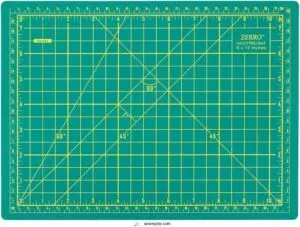
A knight in shining armor for your crafting table, the Self Healing Rotary Cutting Mat is a durable defender against cuts and nicks.
Sized at 12 x 9 inches, it’s a compact yet versatile companion for various crafts and hobbies.
The inch grids, 45° and 60° angles, and smooth surface make measuring and marking a breeze.
Its self-healing powers guarantee a long-lasting, pristine work area, preserving your larger mats and tables from battle scars, making it a valuable tool with long-lasting benefits.
Best For: Crafters, quilters, and hobbyists looking for a durable, versatile, and well-priced cutting mat.
- Compact yet versatile, protecting larger mats and tables from cuts and nicks.
- Long-lasting self-healing powers keep the surface pristine.
- Inch grids, angles, and smooth surface simplify measuring and marking.
- Not suitable for cutting thick or dense materials that require more pressure, like ripstop nylon.
- Smaller size may limit its use for larger projects.
- Does not include a rotary cutter, so you’ll need to provide your own.
2. Self Healing Sewing Cutting Mat
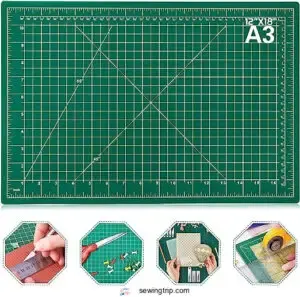
While you’re prepping for your next sewing project, a self-healing sewing cutting mat is a knight in shining armor, saving your table from wayward slices.
This mat is a trusty sidekick, with a non-slip surface that keeps your fabric stable as you cut, and clear markings for precise cuts and sizing.
It’s a durable, 5-ply mat, ready for rotary or straight blades to make their mark.
Plus, with a self-healing surface, it’s like a warrior that heals in a jiffy, ready for the next battle, and provides a non-slip surface.
Best For: Sewers, quilters, crafters, and anyone who regularly cuts fabric or other materials.
- Self-healing surface prolongs mat life and maintains a smooth cutting surface.
- Non-slip bottom keeps the mat and material in place for accurate cutting.
- Clear markings and gridlines ensure precise measurements and cuts.
- May have an initial strong odor that dissipates quickly.
- Not suitable for all cutting tools (e.g., some may damage the surface).
- Larger sizes can be bulky to store.
3. Rotary Cutter Quilting Craft Kit
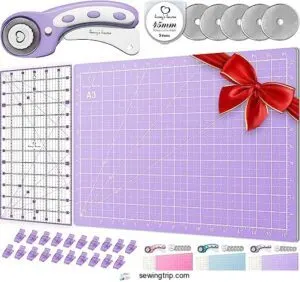
Honey’s Heaven" has your back with its Rotary Cutter Quilting Craft Kit.
This kit is a one-stop shop, including a sharp 45mm rotary cutter with a safety handle, a double-sided, heavy-duty self-healing mat, a clear acrylic ruler, extra blades, clips, and peel-away disks.
With nearly 10,000 reviews and a 4.7 rating, it’s a hit with crafters, sewers, and quilters.
The kit’s a steal, too, offering pro-level tools at a beginner’s price.
When selecting a rotary cutter, consider the best rotary cutter options to make certain you find the right tool for your sewing projects, which can be a part of a quilting craft.
Best For: Quilters, crafters, and sewists looking for a comprehensive starter kit with professional-quality tools at an affordable price point.
- Exceptional value with everything needed to start quilting, including a premium rotary cutter, self-healing mat, and durable acrylic ruler
- Ergonomic design with safety features makes it comfortable for extended use, especially beneficial for those with arthritis
- High-quality materials and construction, with the self-healing mat remaining durable after a year of regular use
- The 18"x12" mat size may be too small for larger quilting projects
- Limited color options available in the basic kit
- Some users might need to purchase additional specialized accessories for advanced quilting techniques
4. Rotating Self Healing Cutting Mat
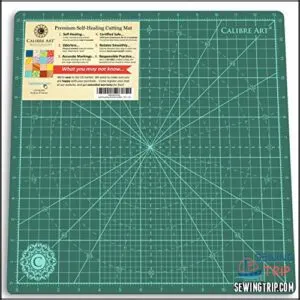
You’ll love how this mat pirouettes like a dancer on its ball-bearing track, making precise cuts a breeze.
The 14.3-inch surface stays put when you apply pressure, letting you focus on accuracy.
Its self-healing compound reseals after cuts, while highly accurate grid lines guide every slice.
Users rave about its durability and smooth rotation mechanism, though there’s a brief new-mat smell that quickly fades.
The non-slip base keeps everything steady, and EN 71-3 compliance means you’re getting high-quality for your money.
Best For: Quilters, crafters, and precision-focused artists who need smooth 360-degree rotation for detailed cutting projects.
- The ball-bearing rotation system allows seamless movement while keeping the mat stable during intricate cuts
- Self-healing surface extends the mat’s life by resealing after cuts, making it a durable long-term investment
- High-quality construction with EN 71-3 compliance ensures safety and precision with accurate grid lines
- Initial chemical odor when first unpacking requires ventilation, though it dissipates quickly
- At 14.3 inches, the size may be limiting for larger projects that require more cutting space
- Higher price point compared to standard non-rotating cutting mats due to the specialized rotating mechanism
5. Self Healing Cutting Craft Mat
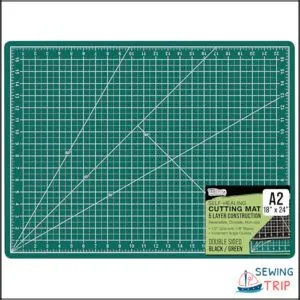
The precision you’re after comes alive with this professional-grade mat, built with 5-ply construction, it features an ultra-precise 1/2" grid with 1/8" marks and 45°/60° guides for perfect alignment.
The reversible green/black design works double-duty, while diagonal cutting lines give you more creative options.
Its non-slip surface keeps your fabric steady and protects your table, what’s more, the self-healing technology actually reseals shallow cuts, maintaining a smooth surface that’ll keep your blades sharp for countless projects.
Best For: Crafters, quilters, and artists seeking a professional-grade cutting surface with precise measurements and surface protection.
- Self-healing technology extends mat and blade life by resealing after cuts, making it perfect for repeated use
- Dual-sided green/black design with detailed grid system and angle guides ensures precise cuts and measurements
- Non-slip surface keeps materials firmly in place while protecting work surfaces from damage
- At 24" x 18", may be too small for larger fabric projects or pattern cutting
- Premium features make it more expensive than basic cutting mats
- Being made of plastic, it may warp if exposed to extreme temperatures or direct sunlight
6. Alvin Self Healing Cutting Mat
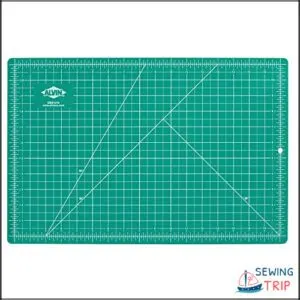
Think of the Alvin Self Healing Cutting Mat as your dependable sidekick for precise cutting projects.
Its reversible green and black sides offer versatility, while the self-healing surface keeps cuts invisible, extending its life.
The non-glare finish and printed grids make lining up fabric a breeze.
Users rave about its durability, whether you’re slicing through fabric or balsa wood.
Available in sizes from compact to massive, it suits any workspace.
Bonus: it’s easy to clean and stands up to repeated use.
Best For: Professionals and hobbyists who need a durable, self-healing cutting mat for precise cutting tasks across various materials.
- Reversible green and black sides with a non-glare finish for better visibility.
- Self-healing surface extends durability and conceals cuts for a seamless workspace.
- Wide range of sizes available to fit any project or workspace.
- Initial strong smell when first unwrapped may be off-putting.
- Larger sizes can be cumbersome to store or move around.
- May wear down slightly over time with heavy repeated use.
7. Fiskars Rotary Cutter Fabric Cutting Set
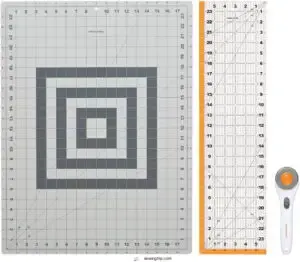
Fiskars Rotary Cutter Fabric Cutting Set is a powerhouse for sewing projects.
With a 45mm rotary cutter, an 18” x 24” self-healing mat, and a sewing ruler, this kit simplifies cutting multiple fabric layers, felt, and vinyl.
The cutter’s sharp blade guarantees clean, effortless cuts, and the mat’s double-sided surface prolongs its lifespan.
The ruler’s highlighted seam allowances make precision easy, although better grip tabs would be a bonus.
This versatile, durable set is perfect for beginners and pros alike.
Best For: Beginners and experienced crafters looking for a reliable, durable, and versatile fabric cutting set for sewing, quilting, and DIY projects.
- Sharp 45mm rotary cutter allows clean cuts through multiple layers of fabric.
- Self-healing double-sided cutting mat with clear, easy-to-read grid lines for accurate measurements.
- High-quality tools offer great value compared to purchasing items separately.
- The sewing ruler lacks grip tabs, which can cause it to move during use.
- Limited blade size options in this kit for specialized cutting needs.
- Not ideal for cutting extremely thick materials like heavy-duty upholstery.
Cutting Mat Features
When choosing a cutting mat, it’s important to focus on features like material, surface texture, and grid markings.
These details can affect your cutting accuracy and protect both your workspace and tools.
Intended Use and Purpose
Knowing your fabric selection and crafting needs shapes the purpose of your cutting mat.
Small sewing tools work fine for simple sewing goals, while larger mats pair well with ambitious fabric cutting or quilting supplies.
Consider your project planning—if you’re layering fabrics for sewing projects, a spacious, durable mat guarantees precision and saves time, making every cut smoother, which is essential for quilting supplies.
Material and Thickness
Fabric density and material types dictate a cutting mat’s thickness levels and cutting resistance.
Thicker self-healing mats handle rotary cutter use better, preserving blade durability and protecting surfaces against deep cuts.
PVC mats are flexible, while layered designs offer long-term durability.
Opt for thickness based on project needs—too thin, and cuts penetrate; too thick, precision suffers.
When selecting a mat, consider the importance of a Rotary Cutting Mat for enhancing overall sewing performance.
Hard Vs. Soft Surface
Hard surfaces offer greater edge retention and cutting resistance, but soft surfaces, like a self-healing mat, excel at extending blade life and minimizing friction levels.
When comparing material durability, hard mats handle heavier rotary cutter use, while softer ones protect fabric cutting tools better.
Both types enhance precision, so your choice depends on cutting frequency and project demands.
The best cutting mat self healing properties are often determined by the quality of the self healing materials used in their construction.
Surface Texture and Grids
A rotary cutting mat with the right surface finish and grid patterns can save you headaches.
Grid lines improve cutting accuracy, while smooth textures guarantee your fabric grip stays solid.
Look for these features:
- Pre-printed grid lines for measurements.
- Self-healing mats that last longer.
- Non-slip surface to steady your work.
- Reversible mats for flexibility.
- Durable materials for heavier projects.
Effective Cutting Techniques
Cutting fabric with precision doesn’t have to be a headache if you follow a few simple techniques.
With the right tools and steady hands, you’ll get clean, accurate cuts every time.
Proper Cutting Technique and Safety
Keeping your fingers and eyes safe matters when using a rotary cutter.
Always cut on a rotary cutting mat, press firmly, and cut away from your body.
Sharp blades prevent Cutting Errors, so replace dull ones regularly.
Use rulers to guide cuts and shield your hands.
Double-check safety features like blade locks to avoid accidents.
Steady Pressure and Layering Fabric
Keeping fabric cutting accurate starts with steady pressure and proper fabric stacking.
Use a rotary cutter on self-healing cutting mats for smoother results.
Layering fabric saves time but keep edges aligned for consistent shapes.
- Apply even pressure for clean cuts.
- Stack fabric layers carefully, avoiding shifts.
- Watch your grip—it’s the secret to better control and improved layer alignment, ensuring accurate cuts with proper fabric stacking.
Correct Mat Placement and Ruler Alignment
Before cutting, make certain your rotary cutting mat lies flat with its grid calibrated to your fabric’s layout.
Use an acrylic ruler for precise ruler placement, aligning edges snugly, and press firmly while keeping the ruler steady.
For cutting accuracy, press firmly while keeping the ruler steady, and remember that fabric smoothing prevents slips—pair this with a self-healing mat for seamless cuts.
Mat alignment tips make all the difference!
Maintenance and Cleaning of Cutting Mats
Even a self-healing mat needs TLC to stay smooth and reliable.
Use these cutting mat care tips:
- Clean regularly with mild soap and a soft brush.
- Remove fabric residue with a lint roller or tape.
- Avoid harsh chemicals or heat exposure.
- Store mats flat to prevent warping.
- Treat deep cuts by gently brushing out debris.
Your mat deserves TLC!
Frequently Asked Questions (FAQs)
What is the main disadvantage in using a rotary cutter and mat?
It’s freedom versus frustration—rotary cutters and mats demand extra space and can dull or wear down over time.
You’ll need regular blade replacements and consistent mat maintenance to keep everything smooth, precise, and in top shape, which is related to the idea of frustration.
Are rotary cutters good for sewing?
They’re fantastic!
Rotary cutters save you time, reduce hand fatigue, and make precise, straight cuts a breeze.
Whether you’re cutting single-layer fabric or multiple layers, they’re a game-changer for sewing efficiency and accuracy.
What type of mat do you use when cutting with the rotary cutter?
You’ll want a self-healing cutting mat with a grid.
It protects your surface, keeps cuts smooth, and handles wear like a champ.
Bonus: non-slip backing stops it from scooting around while you work.
What size rotary cutter is best for dressmaking?
Measure twice, cut once" rings true.
For dressmaking, a 45mm rotary cutter works best.
It’s versatile, handles curves and straight edges seamlessly, and cuts multiple fabric layers effortlessly—saving time without sacrificing precision.
What is the lifespan of a rotary cutter?
How long your rotary cutter lasts depends on use and blade maintenance.
With regular fabric cutting, blades dull after several weeks or months.
Replacing dull blades and proper care can keep your cutter in great shape.
Can rotary mats be used outdoors?
Imagine this scenario: a picnic blanket that can’t stand the wind.
Similarly, rotary mats outdoors struggle with uneven surfaces and dirt.
While possible, they’re best used indoors for stability, longevity, and clean cuts.
Are rotary cutter blades universal?
Not all rotary cutter blades are universal.
Sizes and compatibility vary by brand and model.
Always check your cutter’s manual to verify the blade fits, and don’t assume a “one-size-fits-all” approach—it’s risky!
How do I store large cutting mats?
Store large cutting mats flat under a bed or sofa to prevent warping.
If space is tight, hang them on sturdy hooks or clips in a closet.
Avoid rolling them; creases can distort alignment.
Do rotary cutters work on leather?
Ever sliced steak with a butter knife? That’s scissors on leather.
Rotary cutters can handle leather but need a sharp blade.
Use steady pressure, a self-healing mat, and test on scraps first!
Conclusion
Finding the right tools—sharp rotary cutters and dependable self-healing mats—makes all the difference in sewing.
Whether you’re quilting, crafting, or tackling bigger projects, a solid setup helps you cut with precision and ease.
Look for ergonomic handles, tungsten steel blades, and non-slip mats designed for durability.
With the best rotary cutter and mat for sewing projects, you’ll save time, reduce frustration, and create cleaner lines every time.
Why settle for less when quality tools make it effortless?
- https://siemachtsewingblog.com/2023/01/fabric-cutting-mats/
- https://www.stringandstory.com/blog/rotarycutter
- https://www.amazon.com/rotary-cutter-mat/s?k=rotary+cutter+and+mat
- https://www.allfreesewing.com/Basics-and-Tutorials/Rotary-Cutter-Blade-Guide-NSM2020
- https://madamsew.com/blogs/sewing-blog/choosing-a-rotary-cutter-size

